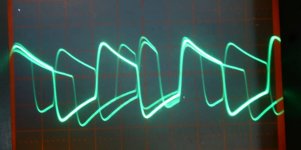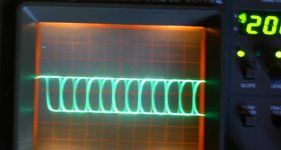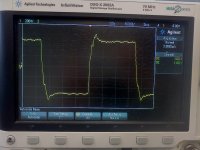Hi
Just by used sony dvd player with 24bit 192khz coax output. I connected it to my amp and compere it with another dvd player (Chinese) with coax output.
There is difference in the sound quality between sources. Why??
As far as I know its only '0' and '1'. yas i know about the jitter, but om not sure it is the jitter
Now that im looking for source for my audio system, how I know what to choose?
Thanks
Just by used sony dvd player with 24bit 192khz coax output. I connected it to my amp and compere it with another dvd player (Chinese) with coax output.
There is difference in the sound quality between sources. Why??
As far as I know its only '0' and '1'. yas i know about the jitter, but om not sure it is the jitter
Now that im looking for source for my audio system, how I know what to choose?
Thanks
Last edited:
The answer lies in the output circuit of the digital signal. Some outputs have a bad rise time of the digital signals, and when sourced thru a coaxial cable the signal gets worse, due to impedance mismatch. This is explained on the Lukasz Fikus pages here:
CD Transport Digi-Lampizator
He likes to put valves at the output, but I believe that proper impedance matching doe´s it all. And then the price of the cables don´t matter anymore
/Seppo
CD Transport Digi-Lampizator
He likes to put valves at the output, but I believe that proper impedance matching doe´s it all. And then the price of the cables don´t matter anymore
/Seppo
Last edited:
Just by used sony dvd player with 24bit 192khz coax output. I connected it to my amp and compere it with another dvd player (Chinese) with coax output.
There is difference in the sound quality between sources. Why??
The most likely cause of SQ differences is common-mode noise. Nowadays players have switched-mode PSUs inside which are fairly hideous noise sources. The more 'audiophile' players tend to eschew switching supplies for linear ones.
There are though other possibilities. Not all players are going to give you the unadulterated bits off the disc - many implement a volume control in the digital domain for example. Even at maximum volume they may well not be bit-perfect.
Jitter could be an issue, it does rather depend one what the DAC is in your amp. If its S-D type, these tend to be more jitter sensitive than the older multibit types.
There is difference in the sound quality between sources. Why??
Short answer : because your amp is crap.
Long answer : your digital sources output the same bits (this is easy to check). If they do not (CD723 is a notable example), due to a buggy volume control for instance, they are crap. Sell them on ebay. Once this matter is investigated and bits are actually bits, the only difference is common mode noise and jitter in the digital signal. Unfortunately it is a difficult job for your receiver to ignore those. Most likely all noise is processed as signal. For example it uses a CS84xx SPDIF receiver which has a jitter rejection of zero. It also, probably, has bad grounding, thus common mode noise is coupled into sensitive circuits. In other words, your receiver is crap.
Last edited:
I don't think I've seen one DAC design where the digital input has been properly implemented vis-a-vis common-mode noise. So there's a hell of a lot of crap out there, no matter whether its bog-standard consumer or 'audiophile' grade. Hardlly any designer seems to 'get' common-mode noise - Berkeley Audio Designs is about the only exception I've noticed.
The first image is easy to believe as not sounding as good as the second...
Why?
Well, Here are two images from the same player, before and after mod ala Lukasz. .
Just a cursory eye-ball but certainly looks to me as though your mod has added jitter. The zero crossings are looking wider - meaning the eye pattern is closing.
abraxalito,
I can agree that the signal seems to have added jitter, but the focus of the photo is poorer thou...
Sy
As ín the digital world the signals are intepreted as either "1" or "0". You know this, but I will explain furher In the ocillogram posted of the bad signal, you can see that the zero passages are divided in time, that are, they dont come regulary in time. And when such signals are transmitted thru a coax, or balanced cables, especially if the impedances not are matched, the signal gets more distorted in the timedomain. So when this distorted signal reaches the DAC, the signal is distorted and so is the output from the DAC.
In the ocillogram posted of the bad signal, you can see that the zero passages are divided in time, that are, they dont come regulary in time. And when such signals are transmitted thru a coax, or balanced cables, especially if the impedances not are matched, the signal gets more distorted in the timedomain. So when this distorted signal reaches the DAC, the signal is distorted and so is the output from the DAC.
In the second oscillogram the signal is with less jitter, and with much less distortion of the square wave, as it should look like when arriving at the DAC
I can agree that the signal seems to have added jitter, but the focus of the photo is poorer thou...
Sy
As ín the digital world the signals are intepreted as either "1" or "0". You know this, but I will explain furher
In the second oscillogram the signal is with less jitter, and with much less distortion of the square wave, as it should look like when arriving at the DAC
As ín the digital world the signals are intepreted as either "1" or "0". You know this, but I will explain furherIn the ocillogram posted of the bad signal, you can see that the zero passages are divided in time, that are, they dont come regulary in time.
Trying to judge jitter on an oscilloscope is useless. Absolutely the wrong instrument for it.
Hahaha, we all have our pet subjects, some are odd, some are subjective and others are objective 
As a technician I rely to the measurable, and adjust my ears to what I see om my instruments. Others look first at the pricetag, then evaluate the sound. What sounds the best I will not dispute, as it is all subjective in the end
As a technician I rely to the measurable, and adjust my ears to what I see om my instruments. Others look first at the pricetag, then evaluate the sound. What sounds the best I will not dispute, as it is all subjective in the end
Ok SY, but a digital signal should have near infinitely small risetimes, and a flat response. Wich my first oscillograph didn´t have, but nearly so the second one.
When the first signal have reached the digital input receiver, the signal is not time correleated. The same phenomen can be seen in optical cables also, the zerocrossings don´t come regulary in time, as they should...
This time jitter makes the sound sound worse than necessary. And expensive cables can make the distortion worse, (or maybe lesser). But its up to the digital sender circuit to do the work good, as my oscillographs taken from the Lampizator.eu webpages can show
When the first signal have reached the digital input receiver, the signal is not time correleated. The same phenomen can be seen in optical cables also, the zerocrossings don´t come regulary in time, as they should...
This time jitter makes the sound sound worse than necessary. And expensive cables can make the distortion worse, (or maybe lesser). But its up to the digital sender circuit to do the work good, as my oscillographs taken from the Lampizator.eu webpages can show
Ok SY, but a digital signal should have near infinitely small risetimes, and a flat response.
Not really necessary, that's not how the data is read.
Again, an oscilloscope tells you nothing about the jitter. It's the wrong instrument, and when you interpret the wrong measurement the wrong way (by eye), you end up with wrong conclusions.
The important jitter is at the DAC, not the external datastream. And you can't use a scope to measure it there, either. You can look at the analog output, which is all you really care about anyway, and see if the interface differences result in any kind of actual difference.
SY,
You have an analog view at the digital distortion. A DAC is only converting the digital stream into analog data. Is the digital signal suffering from jitter in the timedomain, the analog data out will suffer. At the input of the digital receiver where the SPDIF signal enters, is a circuit that recovers the digital signal out of the "analog" signal sent via the coax, or Toslink. This signal, as seen in the oscillographs I´ve posted can look good or bad. A bad signal in means that the signal is not accurate in the timedomain, and this means unless the signal is reclocked that the output has the same inaccuracy in the timedomain. This signal is then forwarded to the DAC, and the output has the same jitter as the input, thus poorer sound than necessary.
That´s my view on this matter
/Seppo
You have an analog view at the digital distortion. A DAC is only converting the digital stream into analog data. Is the digital signal suffering from jitter in the timedomain, the analog data out will suffer. At the input of the digital receiver where the SPDIF signal enters, is a circuit that recovers the digital signal out of the "analog" signal sent via the coax, or Toslink. This signal, as seen in the oscillographs I´ve posted can look good or bad. A bad signal in means that the signal is not accurate in the timedomain, and this means unless the signal is reclocked that the output has the same inaccuracy in the timedomain. This signal is then forwarded to the DAC, and the output has the same jitter as the input, thus poorer sound than necessary.
That´s my view on this matter
/Seppo
erez1012, to me that waveform is perfectly OK, and cannot be bettered in anyway. But where did you take this curve, at the output of the player, or the SPDIF input at the DAC?
This is how the waveform should look like when it enters the SPDIF input at the digital receiver in the DAC.
This is how the waveform should look like when it enters the SPDIF input at the digital receiver in the DAC.
that waveform looks perfectly fine.
Did you check the bits ? Play a CD, record SPDIF out with your PC soundcard digital input, compare WAV with what you burned to the CD, get result. If what comes out of the SPDIF is not what you burned on the CD, then you you know what went wrong.
The left one has too much highpass filtering, probably due to a too small capacitor or cheap transformer... the one on the right looks OK...
Well its complicated... chokes provide some impedance but since you need 2 impedances to make a filter, and the other one isn't clearly defined or very low, the only thing remaining is to short HF common mode noise to the chassis...
And then in 99% of products we see a SPDIF transformer to get rid of ground loops. This opens a huge can of worms at HF.
Jitter doesn't exist in digital data, only in analog...
Actually the receiver extracts two distinct informations :
- the digital data, which is usually perfectly error-free, it is a stream of bits, there is no concept of time or jitter here, only bit errors or the lack of them
- and an analog signal, the clock... which is the one which suffers...
Low amounts of jitter matters only when this dirty clock is used to convert digital data to analog. For correct data recovery huge amounts of jitter are perfectly allowable.
The big flaw of SPDIF is that it transmits the clock with the data...
Unfortunately this isn't measurable with a scope.
Well, you could trigger on the CDP's master clock and scope the SPDIF receiver's recovered MCLK. That would give you an idea of the jitter added in transit, but not the total jitter. If the jitter is reasonably low, it will be invisible on the scope. If it is visible on the scope, yikes.
You can play the usual high frequency sine wave, record it, and look at the width of the peak on a FFT. It will look different depending on the amount of jitter.
Did you check the bits ? Play a CD, record SPDIF out with your PC soundcard digital input, compare WAV with what you burned to the CD, get result. If what comes out of the SPDIF is not what you burned on the CD, then you you know what went wrong.
Well, Here are two images from the same player, before and after mod ala Lukasz. The first image is easy to believe as not sounding as good as the second...
The left one has too much highpass filtering, probably due to a too small capacitor or cheap transformer... the one on the right looks OK...
I don't think I've seen one DAC design where the digital input has been properly implemented vis-a-vis common-mode noise. So there's a hell of a lot of crap out there, no matter whether its bog-standard consumer or 'audiophile' grade.
Well its complicated... chokes provide some impedance but since you need 2 impedances to make a filter, and the other one isn't clearly defined or very low, the only thing remaining is to short HF common mode noise to the chassis...
And then in 99% of products we see a SPDIF transformer to get rid of ground loops. This opens a huge can of worms at HF.
Is the digital signal suffering from jitter in the timedomain.
Jitter doesn't exist in digital data, only in analog...
At the input of the digital receiver where the SPDIF signal enters, is a circuit that recovers the digital signal out of the "analog" signal sent via the coax, or Toslink.
Actually the receiver extracts two distinct informations :
- the digital data, which is usually perfectly error-free, it is a stream of bits, there is no concept of time or jitter here, only bit errors or the lack of them
- and an analog signal, the clock... which is the one which suffers...
Low amounts of jitter matters only when this dirty clock is used to convert digital data to analog. For correct data recovery huge amounts of jitter are perfectly allowable.
The big flaw of SPDIF is that it transmits the clock with the data...
Unfortunately this isn't measurable with a scope.
Well, you could trigger on the CDP's master clock and scope the SPDIF receiver's recovered MCLK. That would give you an idea of the jitter added in transit, but not the total jitter. If the jitter is reasonably low, it will be invisible on the scope. If it is visible on the scope, yikes.
You can play the usual high frequency sine wave, record it, and look at the width of the peak on a FFT. It will look different depending on the amount of jitter.
Last edited:
Ok SY, but a digital signal should have near infinitely small risetimes, and a flat response. Wich my first oscillograph didn´t have, but nearly so the second one.
Not true, the rise time should be sufficient for the signal being transmitted, making it faster than it needs to be can add more problems.
Well, Here are two images from the same player, before and after mod ala Lukasz. The first image is easy to believe as not sounding as good as the second...
These pictures are directly from the site you linked to earlier, and like the information on there, designed to promote putting a valve for the digital output!!!!! A 74 series line driver would do exactly the same job, just as well.
- Status
- This old topic is closed. If you want to reopen this topic, contact a moderator using the "Report Post" button.
- Home
- Source & Line
- Digital Source
- digital output quality different?


